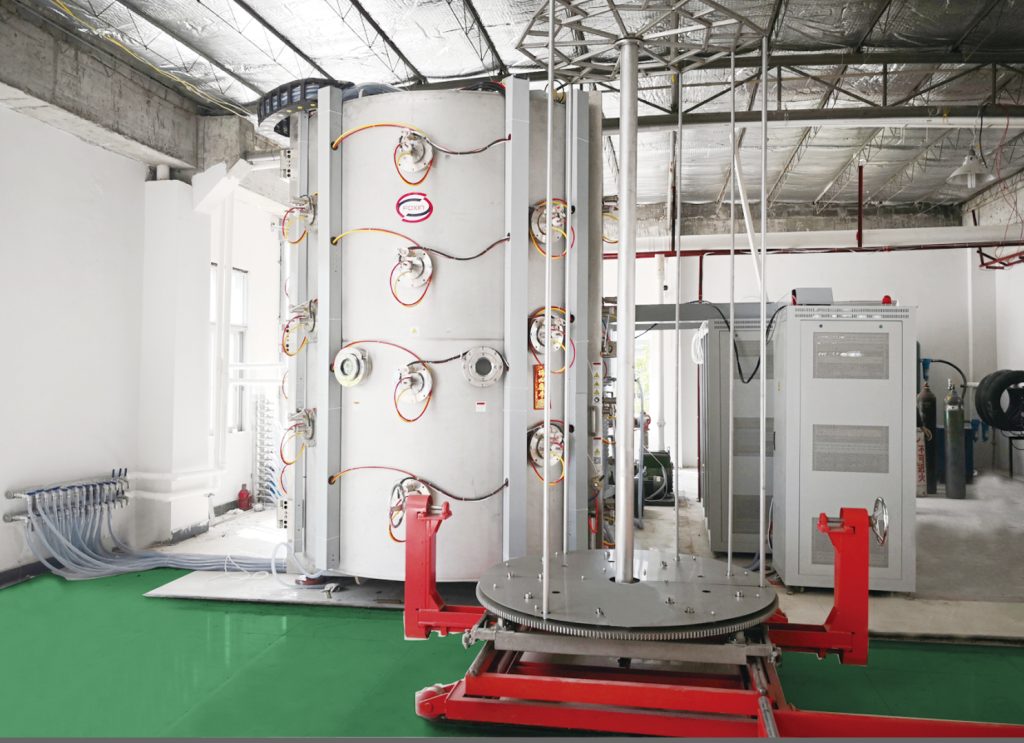What Are the 4 Processes in the PVD Method
From material vaporization, particle transport, surface adhesion to film formation, these four processes are interlinked, and the precise control of each step directly affects the performance and quality of the final coating. As a complex and important technology, PVD method not only pushes the boundaries of innovation, but also brings countless conveniences to our daily lives.
Process 1: Material Vaporization
In the PVD method, the process kicks off with material vaporization. This step is all about turning solid materials into gaseous particles, setting the stage for the deposition that follows. Picture a teapot on your stove: as it heats up, the water inside transforms from liquid to steam and wafts away. The PVD process is somewhat similar, but instead of water, we’re dealing with metals, ceramics, or composite materials. Plus, it usually happens in a vacuum environment. Here’s the cool part: the material doesn’t melt. Instead, it goes straight from solid to gas, kind of like how ice cubes in winter silently turn into vapor on a radiator. This unique transformation is one of the core features of the PVD method.
Thermal Evaporation: The Basics
Simply put, the PVD method involves heating a material until it hits its evaporation point, causing it to “leap” straight into a gaseous state. Take aluminum as an example. It melts at 660°C, but in a vacuum, when you heat it to that temperature, the aluminum atoms quickly break free from the solid surface and turn into gas molecules. The beauty of this technique? It’s straightforward and cheap to run, making it perfect for some essential, everyday applications. For instance, the transparent conductive layer on your phone screen or the gold coating on jewelry often comes from this heat-based evaporation process.
Here are three common types of thermal evaporation techniques:
| Technique | Best For | Key Advantage | Typical Use |
|---|---|---|---|
| Resistive Heating | Gold, Silver, Aluminum | Equipment maintenance is a breeze, low cost | Jewelry gold plating |
| Electron Beam | Tungsten, Molybdenum, Titanium | Handles high-melting-point materials | Tool-strengthening coatings |
| Laser Evaporation | Composites | Pinpoint thickness control | Solar cell films |
Sputtering: The Particle Smash
Picture this: you’re tossing marbles at a pile of sand, and the grains fly everywhere. In sputtering, high-energy argon ions are the “marbles,” slamming into a target material and knocking its atoms loose as gas particles. The big perk? You don’t need to heat the material to its melting or boiling point, so it’s great for tough, high-melting stuff like tungsten. Sputtering tech gets the job done at room temp.
Here’s how sputtering modes stack up:
- DC Sputtering: Best for metals, budget-friendly, and a go-to for basic coatings.
- RF Sputtering: Made for insulators like ceramics, dodging charge buildup issues.
- Magnetron Sputtering: Uses magnetic fields to trap electrons, boosting speed and film quality—think shiny phone casings.
With sputtering, the details matter. The distance between the target and substrate usually sits at 8-15 cm. Too close, and the substrate might overheat (above 400°C) and get damaged; too far, and the particles lose steam, tanking efficiency. A 2019 study in Vacuum Science and Technology found this range strikes the perfect balance between heat and particle delivery for uniform, high-quality films.
Process 2: Particle Transport
Once the material’s vaporized, it’s time for the particles to hit the road in the particle transport phase. Think of it like a delivery driver hauling a package from the warehouse to your doorstep: the particles “take off” from the target, cruise through a vacuum, and aim to land on the substrate. But not every particle makes it—some crash into stray gas molecules, veer off course, or fizzle out. That unpredictability makes this step a tricky one in the PVD method.
Vacuum: The Open Highway
For optimal particle transport efficiency, operating in a high-vacuum environment isn’t just helpful – it’s absolutely essential. The PVD (physical vapor deposition) process typically requires vacuum levels between 10⁻³ and 10⁻⁶ Pascal. To visualize this extreme vacuum, imagine removing nearly all the air from an entire football stadium until only about three balloons worth of gas molecules remain.
This ultra-low-pressure environment serves a crucial purpose: it dramatically reduces particle collisions during flight. In deposition terms, we’re essentially eliminating atomic-scale “traffic accidents” that could compromise coating quality. Recent research confirms this effect – a 2021 lab study demonstrated that improving vacuum conditions from 0.1 Pa to just 0.001 Pa resulted in over 40% better coating uniformity, clearly showing how vacuum quality directly impacts deposition performance.
Gas Dynamics: Friend or Foe
The gas environment’s a double-edged sword in this phase:
- Residual Gas Trouble: If oxygen levels creep above 1%, metal particles are prone to oxidation. This can cause the film’s resistance to skyrocket, tanking its conductivity. This is a big deal when crafting conductive films, so keeping an eye on oxygen content is critical.
- Working Pressure Sweet Spot: In sputtering processes, argon is the go-to working gas, with pressure typically dialed in between 0.5 and 3 Pa. This sweet spot ensures solid sputtering efficiency while keeping the film dense and high-quality.
- Reactive Gas Tuning: For reactive sputtering (like oxide or nitride films), you tweak nitrogen or oxygen based on the target’s reactivity. A 2019 Materials Surface Engineering study nailed it: a 95:5 argon-to-oxygen ratio hit 88% transparency and 15Ω/□ resistance—perfect for fancy touchscreens.

Process 3: Surface Adhesion
When particles finally reach the substrate, it’s time for surface adhesion. It’s like a tile guy sticking ceramic onto a wall: some particles “stick” firmly via physical adsorption, while others bounce off or slide away if the surface isn’t just right. Success hinges on substrate temp, cleanliness, and particle speed.
Temperature: The Goldilocks Zone
If the substrate temperature is too low, particles act like raindrops falling into a freezer. They don’t stick well, and the resulting film ends up loose and weak. On the other hand, if the temperature gets too high, say above 400°C, those particles behave like water droplets hitting a scorching hot plate. They either evaporate instantly or scatter everywhere, leaving you with an uneven film. Lab data shows that heating the substrate to 200°C, about the level of medium heat on an induction stove, boosts the sticking rate of aluminum particles to 85%, hitting the sweet spot for quality. In real-world production, like coating car headlights, factories usually keep the temperature around 250°C. This ensures a solid layer without overheating and warping the plastic headlamp housing.
Quality Control’s Big Three
- Temp Tuning: Like cooking a steak, substrate heat shapes film density and structure.
- Particle Speed: Kinetic energy of 20-100 eV is the sweet spot—firm enough to stick, not so hard they splatter.
- Surface Prep: The substrate needs to be squeaky clean (contact angle under 5°), like a fresh phone screen, for max grip.
Process 4: Film Formation
Thin film formation is the final step in the Physical Vapor Deposition (PVD) process, serving as the “big finish” of the entire operation. Picture it like watching a time-lapse video of a plant growing. At first, scattered material atoms land on the substrate surface, settling into tiny “islands.” As more particles join the party, these islands grow and eventually link up, creating a smooth, continuous film. Depending on the application, the film needs specific properties, so the process parameters in this stage are like a chef’s secret seasoning blend, carefully tweaked for the perfect result.
Performance Tweaks: Custom Recipes
Different films, different tricks:
- Hard Coatings (like TiN): 30%-40% nitrogen, -100V bias—tough and wear-resistant for tools.
- Conductive Films (like ITO): Oxygen under 1%, 250°C substrate—high conductivity and clarity for screens.
- Optical Films (like anti-reflective): 0.8-1.2 nm/s deposition, 20 RPM substrate spin—smooth and even for optics.
Post-Processing: The Finishing Touch
- Annealing: 300-500°C for metals, 500-800°C for ceramics.
- Laser Treatment: 10⁴-10⁵ W/cm², 10-100 ns pulses.
- Surface Passivation: 5-10 nm oxide layer via atomic layer deposition (ALD).
PVD in Everyday Life
- Foldable Phones: Hinge coatings that flex and last through 200,000 bends.
- Chip Bags: 0.1-micron aluminum layer triples freshness.
- Sunglasses: Seven-layer coatings block UV and glare.
- Smart Glasses: Anti-fingerprint films keep touch smooth and smudge-free.
Industry forecasts peg the global PVD equipment market at over $12 billion by 2025—proof this tech’s a big deal in precision manufacturing!


